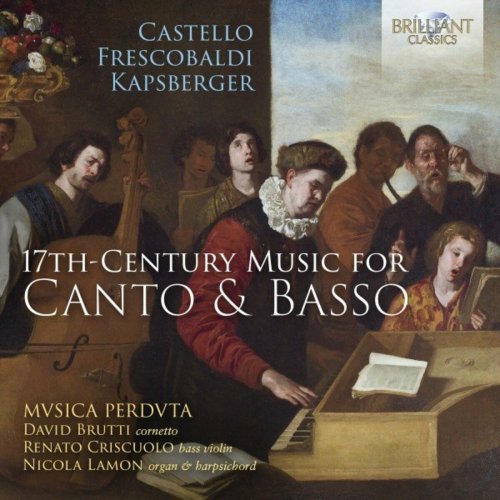
Mvsica Perdvta - 17th-Century Music for Canto & Basso (2023)
BAND/ARTIST: Mvsica Perdvta, David Brutti, Renato Criscuolo, Nicola Lamon
- Title: 17th-Century Music for Canto & Basso
- Year Of Release: 2023
- Label: Brilliant Classics
- Genre: Classical
- Quality: FLAC (tracks+booklet)
- Total Time: 54:14 min
- Total Size: 277 MB
- WebSite: Album Preview
Tracklist:
01. Sonata VII libro II
02. Canzona decimaottava a 2, canto e basso "La Masotti"
03. Sonata VIII libro I
04. Canzona vigesimaseconda a 2, canto e basso "La Nicolina"
05. Canzona ottava "La Vincenti"
06. Sinfonia terza
07. Canzona vigesimaprima a 2, canto e basso "La Tegrimuccia"
08. Sonata VII libro I
09. Canzona decimanona a 2, canto e basso "La Capriola"
10. Toccata quinta sopra i pedali dell'organo e senza
11. Canzona vigesima a 2, canto e basso "La Lipparella"
12. Canzona vigesimaterza a 2, canto e basso "La Franciotta"
13. Sonata VIII libro II
01. Sonata VII libro II
02. Canzona decimaottava a 2, canto e basso "La Masotti"
03. Sonata VIII libro I
04. Canzona vigesimaseconda a 2, canto e basso "La Nicolina"
05. Canzona ottava "La Vincenti"
06. Sinfonia terza
07. Canzona vigesimaprima a 2, canto e basso "La Tegrimuccia"
08. Sonata VII libro I
09. Canzona decimanona a 2, canto e basso "La Capriola"
10. Toccata quinta sopra i pedali dell'organo e senza
11. Canzona vigesima a 2, canto e basso "La Lipparella"
12. Canzona vigesimaterza a 2, canto e basso "La Franciotta"
13. Sonata VIII libro II
The trio sonata was one of the baroque period’s most popular instrumental forms. While in its ‘classic’ form it features two higher-pitched instruments, a melodic bass instrument and basso continuo, there were several others, including a popular variant for one high-pitched instrument, one bass instrument and continuo chosen by a substantial number of composers in the 17th century and beyond and resulting in a significant number of compositions. In this setup, the writing for the melody instrument is more virtuosic than in a ‘conventional’ trio sonata, and it performs more of a solo role, unlike in the trio sonata, where it is more of a first among equals. At the same time, the bass instrument is used idiomatically instead of being relegated to a mere basso continuo. This contributed greatly to bolstering its role as a solo instrument, and it was given ever greater prominence as the second half of the 17th century progressed.
From the numerous Italian composers who wrote for this genre, for this album Mvsica Perdvta have selected the two who had the greatest influence on the establishment and development of chamber music: Girolamo Frescobaldi (1583–1643) and Dario Castello (1602–31). The first edition of Frescobaldi’s Canzoni da sonare a uno, due, tre e quattro, published in Rome in 1628 (and later republished in a slightly different version in Venice in 1634) sits chronologically between the two books of Castello’s Sonate concertate in stil moderno, published in Venice in 1621 and 1629 respectively. While Frescobaldi’s canzoni can be considered the culmination of a genre that was already in decline, Castello ushered in a form that, evolving through countless different variants, would for centuries remain the leading chamber music genre. Castello’s style is faithful to the promise of its title: it still sounds very ‘modern’ for its time, especially when – as in this album – it is paired with the oeuvre of Frescobaldi, the epitome of the instrumental canzona. Completing the CD is a short work by Giovanni Girolamo Kapsberger (Venice, c.1580 – Rome, 1651), the only sonata that the composer known as the ‘Tedesco della tiorba’, or ‘German of the theorbo’, wrote for this ensemble, taken from Il primo libro di Sinfonie a quattro con il basso continuo (Rome 1615).
From the numerous Italian composers who wrote for this genre, for this album Mvsica Perdvta have selected the two who had the greatest influence on the establishment and development of chamber music: Girolamo Frescobaldi (1583–1643) and Dario Castello (1602–31). The first edition of Frescobaldi’s Canzoni da sonare a uno, due, tre e quattro, published in Rome in 1628 (and later republished in a slightly different version in Venice in 1634) sits chronologically between the two books of Castello’s Sonate concertate in stil moderno, published in Venice in 1621 and 1629 respectively. While Frescobaldi’s canzoni can be considered the culmination of a genre that was already in decline, Castello ushered in a form that, evolving through countless different variants, would for centuries remain the leading chamber music genre. Castello’s style is faithful to the promise of its title: it still sounds very ‘modern’ for its time, especially when – as in this album – it is paired with the oeuvre of Frescobaldi, the epitome of the instrumental canzona. Completing the CD is a short work by Giovanni Girolamo Kapsberger (Venice, c.1580 – Rome, 1651), the only sonata that the composer known as the ‘Tedesco della tiorba’, or ‘German of the theorbo’, wrote for this ensemble, taken from Il primo libro di Sinfonie a quattro con il basso continuo (Rome 1615).
Year 2023 | Classical | FLAC / APE
As a ISRA.CLOUD's PREMIUM member you will have the following benefits:
- Unlimited high speed downloads
- Download directly without waiting time
- Unlimited parallel downloads
- Support for download accelerators
- No advertising
- Resume broken downloads


